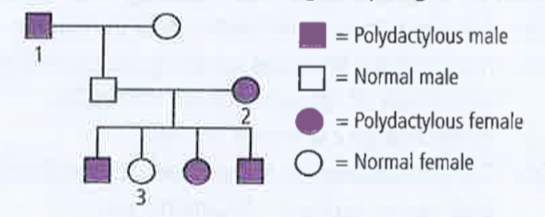In humans polydactyly (i.e., presence of extra fingers and toes) is determined by a dominant autosomal allele (P) and the normal condition is determined by a recessive allele (p). Find out the possible genotypes of family members 1,2 and 3 in the given pedigree
 Solution in Tamil
Solution in Tamil
1 2 3PP Pp pp
1 2 3PP PP pp
1 2 3Pp PP Pp
1 2 3Pp Pp pp
The correct Answer is:D
Given pedigree chart for polydactyly (autosomal dominant trait) can be explained as follows :

Similar Questions
In the pedigree given below, indicate whether the shaded symbols indicate dominant or recessive allele. Also give genotype of the whole pedigree.
View SolutionIn the given pedigree, indicate whether the shaded symbols indicate dominant or recessive allele.
View SolutionIf the frequency of occurrence of dominant allele A is p and that of recessive allele a is q. Then according to Hardy Weinberg law q is equal to.
View SolutionA population has a 1:1 ratio of alleles for a given gene (the dominant and recessive alleles are present in equal numbers). Are more individuals affected if the allele is lethal when present in the dominant condition or in the recessive condition?
View SolutionThere are 36 possible genotypes for an autosomal gene with 8 alleles. How many genotypes will be possible for an X-linked gene with 8 alleles?
View SolutionPresence of recessive trait is 16%. The frequency of dominant allele in population is:
View SolutionGiven below is a pedigree showing the inheritance of an autosomal dominant disorder. The genotypes of person 1, 2 and 3 in this family tree are:
View SolutionIn the given pedigree, indicate whether the shaded symbols indicate dominant or recessive allele.
View Solution
